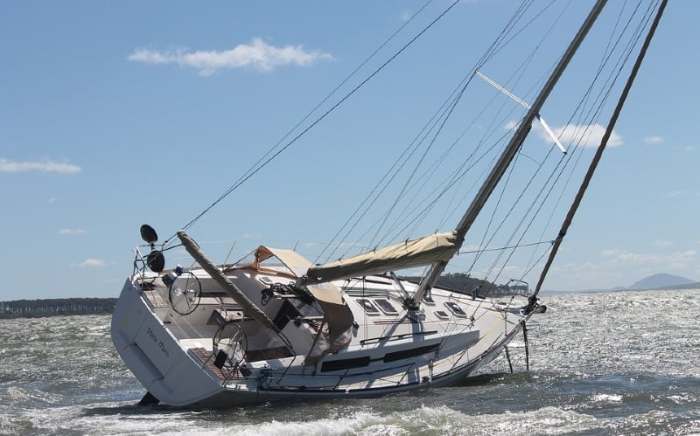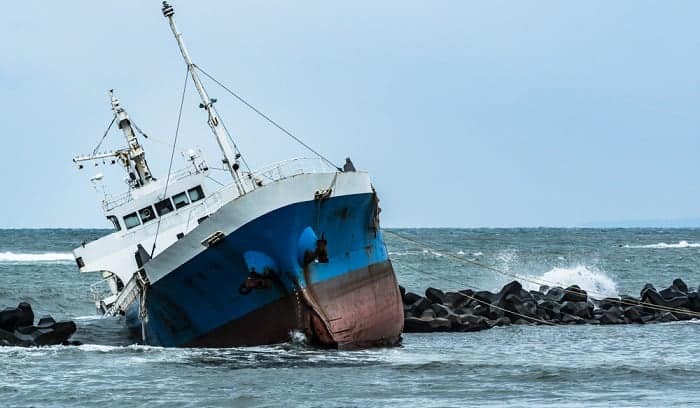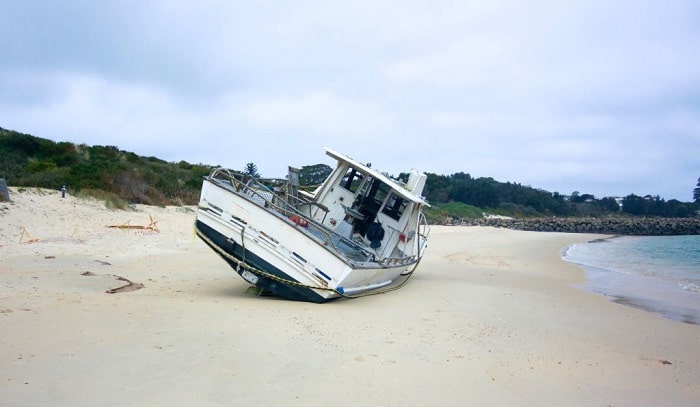If your inboard/outboard runs aground – In the realm of boating, grounding an inboard/outboard vessel can be a harrowing experience. This comprehensive guide delves into the causes, immediate actions, safety procedures, damage assessment, refloating techniques, and post-grounding maintenance, providing a roadmap for mariners to navigate this potentially perilous situation with confidence and competence.
Understanding the factors that contribute to grounding, such as uncharted waters or equipment malfunctions, is crucial for prevention. When an inboard/outboard runs aground, swift and decisive action is paramount. Assessing the situation, ensuring safety, and contacting authorities are essential first steps.
Safety protocols, including the use of emergency equipment and evacuation procedures, should be followed meticulously.
Causes of Inboard/Outboard Running Aground

Inboard/outboard boats, with their shallow drafts and maneuverability, are particularly susceptible to running aground. Grounding occurs when the boat’s hull makes contact with the seabed or other underwater obstructions. The most common reasons for inboard/outboard grounding include:
- Uncharted waters:Unfamiliar or poorly charted waters can lead to unexpected shallows or obstacles that can cause grounding.
- Navigational errors:Human error in navigation, such as misreading charts or failing to account for tidal changes, can result in grounding.
- Equipment malfunctions:Malfunctioning depth sounders or GPS systems can provide inaccurate information, leading to grounding.
According to the United States Coast Guard, grounding is the second leading cause of boating accidents, accounting for approximately 20% of all incidents.
Immediate Actions When Inboard/Outboard Runs Aground

Swift and appropriate actions are crucial when an inboard/outboard runs aground. Ensuring the safety of individuals on board and minimizing further damage are paramount. A well-thought-out response plan can significantly enhance the chances of a successful recovery.
Assess the Situation and Ensure Safety
Upon grounding, the initial priority is to assess the situation and ensure the safety of all individuals on board. Remain calm and avoid any unnecessary panic. Perform the following steps:
- Turn off the engineimmediately to prevent further damage to the drive unit.
- Check for injuriesamong passengers and crew. Provide first aid if necessary.
- Contact the appropriate authorities, such as the Coast Guard or local law enforcement, to report the grounding and request assistance.
- Stay on boardand wait for help to arrive. Attempting to move the vessel without professional assistance can worsen the situation.
Check for Damage, If your inboard/outboard runs aground
Once the situation has been assessed and safety ensured, it is essential to check for damage to the vessel and drive unit. Perform the following steps:
- Inspect the hullfor any cracks, holes, or dents. Look for signs of water ingress, which may indicate a breach.
- Examine the drive unitfor any visible damage, such as bent or broken components. Check the propeller for any nicks or cracks.
- Monitor bilge pumpsand bilge water levels to detect any signs of water accumulation.
Prevent Further Grounding
To prevent the vessel from grounding further or drifting away, it is essential to take the following steps:
- Set an anchorto secure the vessel in place and prevent it from moving.
- Deploy fendersaround the hull to protect it from further damage.
- Use a bilge pumpto remove any accumulated water from the bilge.
- Monitor the situationand be prepared to take further action as needed.
Safety Procedures and Emergency Response: If Your Inboard/outboard Runs Aground

In the event of an inboard/outboard grounding, it is imperative to prioritize the safety of passengers and crew. Adherence to established safety protocols and the proper utilization of emergency equipment are crucial for mitigating risks and ensuring a successful response.
Upon impact, assess the situation and activate the vessel’s emergency position-indicating radio beacon (EPIRB) to alert authorities. Don passengers with life jackets and gather them at the designated assembly point. Ensure all individuals remain calm and follow instructions from the designated safety officer.
Emergency Equipment
Familiarize yourself with the location and operation of all emergency equipment aboard the vessel. This includes flares, life jackets, and communication devices such as VHF radios and cellular phones.
- Flares: Use flares to signal for help, particularly at night or in low visibility conditions.
- Life Jackets: Ensure all passengers and crew wear life jackets, especially during an emergency.
- Communication Devices: Utilize VHF radios or cellular phones to contact the Coast Guard or other emergency services.
Evacuation Procedures
In the event of a severe grounding or if the vessel is taking on water, it may be necessary to evacuate passengers and crew. Follow these guidelines:
- Remain calm and assess the situation.
- Instruct passengers and crew to gather at the designated assembly point.
- Lower lifeboats or life rafts into the water and assist passengers and crew into them.
- Follow the instructions of the designated safety officer and proceed to the nearest safe haven.
Damage Assessment and Mitigation

Methods to Assess Damage
Grounding can cause significant damage to an inboard/outboard, and assessing the extent of damage is crucial to ensure the safety of the vessel and its occupants. Thorough inspections should be conducted to identify any structural damage, leaks, or compromised components.
Inspection of the Hull
The hull is the most vulnerable part of the boat when it runs aground. Inspect the hull thoroughly for cracks, dents, punctures, or any signs of deformation. Pay particular attention to the areas that made contact with the grounding surface, as they are likely to sustain the most damage.
Inspection of the Propeller
The propeller is another critical component that can be damaged during grounding. Check the propeller blades for any bends, nicks, or cracks. Ensure that the propeller shaft is not bent or misaligned, as this can cause further damage to the engine or transmission.
Inspection of Other Components
In addition to the hull and propeller, inspect other components of the inboard/outboard, including the engine, transmission, steering system, and electrical system. Look for any loose connections, damaged wires, or leaks.
Mitigation of Damage
Once the extent of damage has been assessed, immediate steps should be taken to mitigate further damage and ensure the safety of the vessel.
Patching Holes
If the hull has been punctured, it is essential to patch the hole promptly to prevent water from entering the boat. Temporary patches can be made using materials such as duct tape, canvas, or plywood.
Securing Loose Parts
Loose parts, such as deck fittings or railings, can pose a safety hazard and should be secured as soon as possible. Use ropes, bungee cords, or other materials to secure loose items and prevent them from moving around.
Temporary Repairs
In some cases, temporary repairs may be necessary to allow the vessel to return to shore or a repair facility. These repairs can include using epoxy or fiberglass to seal cracks or reinforce damaged areas. However, it is important to note that temporary repairs are not a permanent solution and should be replaced with professional repairs as soon as possible.
Refloating and Recovery Techniques
Refloating an inboard/outboard that has run aground requires careful planning and execution. Various techniques can be employed, depending on the severity of the grounding and the available resources.
In cases where the grounding is minor and the boat can be moved with minimal effort, winches or manual labor may suffice. However, for more severe groundings, external assistance from towboats or salvage crews may be necessary.
Preparing the Boat for Refloating
- Remove all loose items from the boat.
- Secure hatches and compartments to prevent water ingress.
- Disconnect electrical connections and batteries.
- Lighten the load by removing passengers and unnecessary gear.
Using Winches or Manual Labor
If the grounding is minor, winches or manual labor can be used to refloat the boat. Winches can be attached to anchors or trees on the shore, and the boat can be pulled back into the water. Manual labor may involve using levers, ropes, or pushing the boat off the sandbar.
Using Towboats or Salvage Crews
For more severe groundings, external assistance from towboats or salvage crews may be necessary. Towboats can pull the boat off the sandbar, while salvage crews can use specialized equipment to lift the boat back into the water.
Post-Grounding Maintenance and Repairs

Following an inboard/outboard grounding incident, thorough maintenance and repairs are crucial to restore the vessel to its pre-incident condition and prevent future issues. The extent of repairs will depend on the severity of the damage sustained.
Inspection and Damage Assessment
A comprehensive inspection should be conducted to identify all damaged components. This includes examining the hull, propeller, shaft, and other affected areas. The inspection should be thorough and include both visual and hands-on assessments to identify any hidden damage.
Repairs and Replacements
Once the extent of the damage has been determined, repairs or replacements can be made. Hull damage may require patching or welding, while propeller or shaft damage may necessitate replacement. In some cases, the entire inboard/outboard unit may need to be replaced.
It is important to use high-quality materials and follow manufacturer’s recommendations for repairs to ensure the integrity and performance of the vessel.
Underlying Issues
In addition to repairing the immediate damage, it is important to address any underlying issues that may have contributed to the grounding incident. This could include issues with the navigation system, operator error, or environmental factors. By identifying and addressing these underlying issues, the likelihood of future grounding incidents can be reduced.
Detailed FAQs
What are the most common causes of inboard/outboard grounding?
Uncharted waters, navigational errors, and equipment malfunctions are the primary causes of inboard/outboard grounding.
What immediate actions should be taken if an inboard/outboard runs aground?
Assess the situation, ensure safety, check for damage, contact authorities, and prevent further grounding.
What safety procedures should be followed in case of an inboard/outboard grounding?
Use emergency equipment, such as flares, life jackets, and communication devices. Evacuate passengers and crew if necessary.